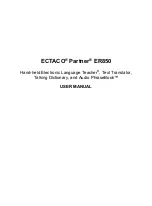
INS-42037-1: FMC88108-6
User’s Manual
Asia Pacific | EMEA | Americas
19
e)
Synthesizer and Loop Filter (87.5MHz
– 108MHz).
The synthesizer consists of a single loop with a divide by 64 pre-scaler
IC14
. Direct carrier modulation is used in this
application. The 6.4MHz crystal circuit provides the reference for the synthesizer
IC10
. The reference is then divided by
8192 by
IC10
to 781.25Hz. This mode of operation provides frequency steps of 50kHz via the 12 way DIP switch
SW2
(64 x 781.25Hz = 50kHz). The DIP switches set the oscillator frequency (87.5MHz
– 108MHz). The LD output on
IC10
provides a lock detect function and is routed to
IC13/B
and LED indicator
D9
.
The phase comparator output of
IC10
(PD-OUT) has a 3-state output and is applied to a loop integrator (
IC11
) and loop
filter (
IC12
) whose DC output in turn controls the frequency of the oscillator (VCO).
f)
VCO and Modulation Inputs.
The modulation inputs from figure 9 via
RL1
are routed to varactor diodes
D13
and
D14
. These provide the modulation
within the Fet oscillator
TR6
. Varactor diodes
D11
and
D12
control the tuning of the modulator/ oscillator
TR6
via the
loop filter. The modulator has a built in DC correction circuit to keep the modulation constant over the frequency range
87.5MHz to 108MHz.
The output of
TR6
is routed to the 64 pre-scaler
IC14
. The output of
TR6
is also routed to buffer
IC15
which provides up
to +10dBm RF output. The current in the IC is controlled via
R97
which reduces the level of its output. This
potentiometer (
R97
) is therefore used to set the output level required during use.
TR7
is provided to ensure that if the Tx
synthesizer is out of lock the output will be switched off.
The RF output from
IC15
is routed to a 6dB splitter whose outputs are routed to diode detection circuit
D15
and
IC16/A
(to detect loss of carrier) and also a low pass filter to remove harmonics from the carrier. The output is then routed to RF
connector
SK4
.
8.2 Distribution and Display PCB Assembly
a)
PSU and BIF Audio.
The BIF (Break In Facility) audio (nom10dBm) is input at
SK3
or
SK4
to a balanced line circuit
IC1/B
. DC
blocking capacitors
C1
and
C2
are provided to ensure no DC component enters the circuit. Capacitors
C3
and
C4
are
provided to ensure that no RF signals can enter the circuit, which would cause audio distortion. The output of
IC1/B
is
routed to
IC1/A
which forms an 8kHz low pass filter with added pre-emphasis lift for optimum voice equalization. This
means that no pre-emphasis would be required at the audio source.
R13
is provided to allow level adjustment on all six
translator modules to achieve approximately 68kHz deviation (nominal) on all six transmitters at the same time. The BIF
signal is distributed to all six connectors
SK7
to
SK12
for this purpose on
pin 4
.
The +15V DC PSU inputs on
SK5
and
SK6
are routed to fuses
F1
and
F2
respectively for protection purposes. These
two supplies are then distributed to
SK7, SK8, SK9
(+15V #1 supply) and
SK10, SK11
and
SK12
(+15V #2 supply).
The two supplies are also combined via diodes
D1
and
D2
to power all other circuits on this module.
b)
RF Amplifier with 6 Way Splitter and Output Combiner.
RF Input Section
The RF input at
SK1
(BNC) is routed to a wide bandpass filter that passes the entire VHF FM band from 87.5MHz to
108MHz. This filter is provided to attenuate signals out of band from entering the RF amplifier stage
IC2
. The RF
amplifier stage
IC2
is operated at 80 mA and has a high 1dB compression point of +19dBm. The amplifier has a power
gain of 25dB
The output of the amplifier
IC2
is routed to a 6 way splitter (
IC3
) which provides six equal outputs for the six translator
modules. The splitter provides excellent isolation of
≥28dB between each output port. The total conversion gain of this
RF section is typ17dB.
RF Output Section
The RF inputs from the six translator modules at
TP7
and
TP12
are routed to a 6 way combiner (
IC4
) which provides a
single output. Loss in the combiner is typically 8dB. The combiner provides excellent isolation of
≥28dB between each
input port, thus keeping intermodulation products to an absolute minimum. The output of the combiner is routed to a
wide bandpass filter that passes the entire VHF FM band from 87.5MHz to 108MHz. This is then routed to SK2 (RF
output).












































